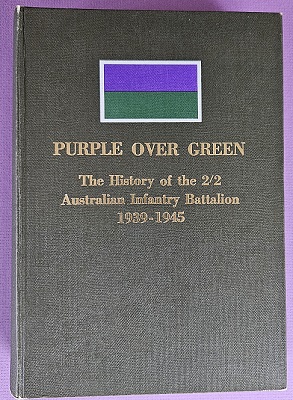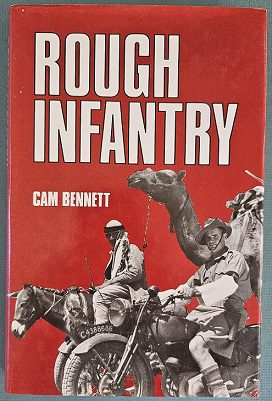Description
Title: The Eighth Battalion AIF – A Personal and Pictorial Record 1937 – 1946
Author: Strange, Norm MM, ED
Condition: Near Mint Plus
Edition: 1st Edition
Publication Date: 1996
ISBN: 0646293443
Cover: Soft Cover without Dust Jacket – 223 pages
Comments: Signed by the author.
The history of the 8th Infantry Battalion (City of Ballarat Regiment) during World War 2.
After the First World War the defence of the Australian mainland lay with the part time soldiers of the Citizens Military Force, otherwise known as the Militia. The Militia was organized to maintain the structure of the First AIF and kept the same numerical designations. These Militia units were also distributed in the same areas that had raised the original AIF units. Consequently, Militia units were also known by the name of their shire. Thus, Victoria’s 8th Infantry Battalion was the “City of Ballarat Regiment”. The battalion was headquartered in Ballarat, with companies established in Ararat, Stawell, and Daylesford.
With the start of the Second World War in 1939, from early October the Militia were called up in two drafts for 30 days training. This was repeated in early 1940, this time for 90 days. Militia units were brought up to strength with men conscripted for service. During 1940 the battalion held a number of training camps. In April the 8th went into camp with the rest of the 6th Brigade (comprising the 7th and 38th Battalions) at Mt Martha on the Mornington Peninsula. A later camp was held in May 1941 at Nagambie Road, north of Seymour in Central Victoria. From August to September and then again in December to January 1942, the 8th exercised at the new Balcombe Camp near Mt Martha. With Japan’s sudden entry into the war, the battalion was needed elsewhere and on 7 February the 8th began moving north.
On 19 February the 8th arrived in Darwin, where it got its first taste of action, as the Japanese bombed the town throughout 1942. It was also in Darwin that the 8th joined the 23rd Brigade. The brigade was previously part of the 8th Division, but when two of its battalions were captured on Ambon and Timor, it was reformed with Militia units – the 7th, 8th, and 27th Battalions.
The brigade spent a year-and-a-half in Darwin, until September 1943 when it returned to Melbourne for some appreciated leave. After a month off, the battalion again headed north, this time to the Atherton Tablelands for intensive training. However, the 8th was destined for more garrison duties.
In mid May the battalion was transferred to Lae, before moving to the Solomon Islands in October 1944. As part of the Bougainville campaign, the 23rd Brigade relieved the American garrisons on the Outer Islands. In October 1944 the 8th took over from the Americans on Emirau Island.
The 8th’s role was to defend the airfield and conduct surveillance of the surrounding islands still occupied by the Japanese. To escape the boredom and monotony, volunteers from the brigade worked as crews on American PT boats, raiding Japanese-occupied islands in New Ireland and New Britain.
In 1945 the 23rd Brigade moved to Bougainville where it was responsible for the Central and Northern Sectors. The 27th and 7th were the first to leave the Outer Islands in March and April respectively. In their absence, the 8th placed a company each on Green, Treasury, and Emirau Islands, while a platoon from the company on Treasury Island defended Munda.
Throughout June members from the 8th were transported from the Outer Islands to Soraken and by the end of the month had relieved the 31/51st Infantry Battalion in the Bonis Peninsula in the Northern Sector.
The 8th, unlike all the other units on Bougainville, had not gone through Torokina, but went directly to Soraken and straight into action in the Northern Sector. It was the worst time to “blood” fresh and inexperienced troops. The Japanese had just repelled the Australian landing at Porton and were harassing and ambushing the Australian lines. Australian positions were regularly shelled and it was not until towards the end of the campaign that the Australians were able to regain the initiative. The 8th’s performance was mixed and its commanding officer was transferred for not following orders.
However, the battalion did have two notable achievements. On 23 July, after successfully using a combination of active patrolling, artillery, and air strikes, the 8th captured Commo Ridge. Japanese position Base 5.
On 24 July 1945 Private Frank Partridge’s unit came under heavy Japanese machine-gun, grenade, and rifle fire from Base 5. Nineteen-year-old Partridge was badly wounded. Ignoring his injuries, he snatched a Bren gun from alongside a dead gunner and challenged the enemy to come out and fight. He then rushed to the nearest enemy bunker while armed with grenades and his knife, and killed the occupants. Finally, he attacked a second bunker until loss of blood stopped him. Partridge’s VC was the only one awarded to a militiaman. Base 5 was renamed Partridge Hill.
After Japan’s surrender the 8th moved back to Soraken Peninsula and then Torokina. Some of the battalion were involved in inspecting the Japanese naval base at Buka. Over time the ranks of the 8th thinned, as men were discharged, transferred, or volunteered for the occupation of Japan. The battalion was disbanded on 2 May 1946.
Lists the members of ‘A’ Coy who served overseas





